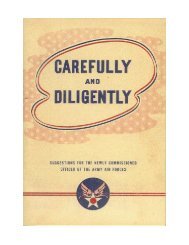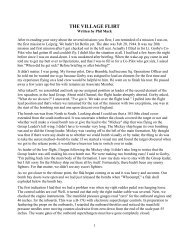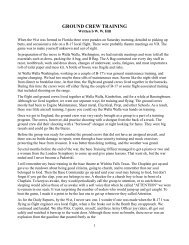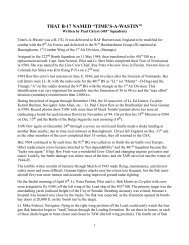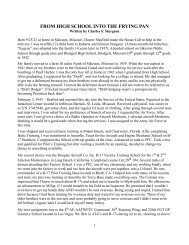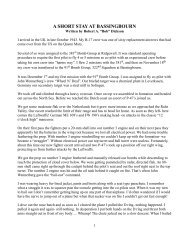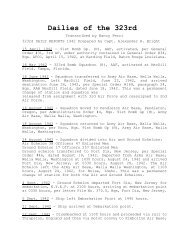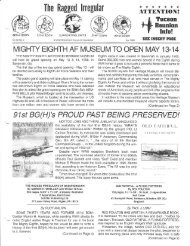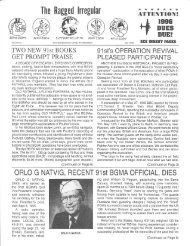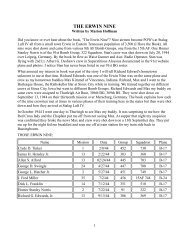THE DELTA REBEL & STEVE PERRI - the 91st Bomb Group!
THE DELTA REBEL & STEVE PERRI - the 91st Bomb Group!
THE DELTA REBEL & STEVE PERRI - the 91st Bomb Group!
Create successful ePaper yourself
Turn your PDF publications into a flip-book with our unique Google optimized e-Paper software.
unway was coming up fast. We went through <strong>the</strong> perimeter fencing, across <strong>the</strong> main road, over a ditch<br />
and between two telephone poles, through a farm full of Brussel sprouts, over a plow which ripped off<br />
<strong>the</strong> ball turret and <strong>the</strong>n we crashed into a haystack and ....stopped.<br />
Perri's experiences refute <strong>the</strong> British claim that <strong>the</strong> ball turret was "quite untenable for long missions"<br />
He estimated that his longest missions involved 6 1/2 to 7 hours actually inside <strong>the</strong> turret. However, he<br />
had completed his tour before <strong>the</strong> really deep penetrations into Germany. For Perri <strong>the</strong> mission<br />
preparations began <strong>the</strong> day before take-off. Each gunner was assigned his own .50 caliber machine<br />
guns which were stored in <strong>the</strong> base armament show between missions. He cleaned and oiled <strong>the</strong>m <strong>the</strong><br />
day after each mission and covered <strong>the</strong> breech mechanism with an athletic sock. When alerted for a<br />
mission, he stopped by <strong>the</strong> armament shop and thoroughly removed <strong>the</strong> oil lest it freeze at altitude and<br />
cause <strong>the</strong> gun to jam. After briefing, <strong>the</strong> gunners drew <strong>the</strong>ir guns and were transported to <strong>the</strong>ir aircraft.<br />
From outside <strong>the</strong> turret, Perri removed a small cover on each side of <strong>the</strong> entrance door and inserted <strong>the</strong><br />
guns into <strong>the</strong>ir rigid mounts. After pre-flighting <strong>the</strong> turret, he helped <strong>the</strong> pilot and flight engineer preflight<br />
<strong>the</strong> aircraft.<br />
The turret was not manned for take-offs and landings. Perri entered and excited while <strong>the</strong> aircraft was<br />
over <strong>the</strong> English Channel. Before entering however, it was time to load <strong>the</strong> guns. While <strong>the</strong> turret was<br />
stowed in take-off position i.e.guns horizontal and facing rearward. The two covers were removable<br />
from inside <strong>the</strong> fuselage. Through <strong>the</strong> openings he fed belted ammunition into <strong>the</strong> turret boxes until full<br />
(approximately 400 rounds each). With a hand crank he depressed <strong>the</strong> turret straight down, which<br />
moved <strong>the</strong> entry door inside <strong>the</strong> fuselage. One of <strong>the</strong> waist gunners helped him get into and out of <strong>the</strong><br />
turret. Inside <strong>the</strong> ball turret <strong>the</strong>re was nei<strong>the</strong>r room for a parachute nor for <strong>the</strong> heavy fleece-lined flying<br />
suit that waist gunners wore. Perri wore coveralls, a light-weight flight jacket and English flying boots,<br />
depending primarily upon <strong>the</strong> electrically-heated undergarment to keep him warm in temperatures as<br />
low as - 30 degrees F. One hazard was burns in <strong>the</strong> groin, resulting from crimped wires in <strong>the</strong> electric<br />
suit. Once inside, he connected his throat mike, earphones and oxygen hose and fastened his safety belt.<br />
He was curled up with his back resting against <strong>the</strong> armored door, his legs bent and his feet resting on<br />
each side of <strong>the</strong> 13-inch diameter armored glass panel which was his main window on <strong>the</strong> world. The<br />
two 50s were just inches away from his head with <strong>the</strong> ammo boxes above <strong>the</strong>m. His face was about 30<br />
inches from <strong>the</strong> armored glass panel and suspended in between was <strong>the</strong> optical display glass for <strong>the</strong><br />
computing gun sight. With his left foot he could adjust <strong>the</strong> lighted reticles projected onto this glass.<br />
When a target was framed by <strong>the</strong>m, <strong>the</strong> range was correct. Two post handles projected rearward above<br />
<strong>the</strong> sight and flexing <strong>the</strong>n moved <strong>the</strong> turret in azimuth and elevation. The firing buttons for <strong>the</strong> guns<br />
were in <strong>the</strong> ends of <strong>the</strong>se handles, hence, to move <strong>the</strong> turret and fire <strong>the</strong> guns, Perri's arms were bent<br />
with his hands above his head. As cramped as it sounds, it was actually quite comfortable "if I was<br />
firing straight out, it was like an easy chair". Perri also refuted <strong>the</strong> common belief that <strong>the</strong> ball was <strong>the</strong><br />
most dangerous crew position. Although he wore his parachute harness, <strong>the</strong> chest pack itself was<br />
stowed in <strong>the</strong> fuselage by <strong>the</strong> radio room bulkhead. A waist gunner was assigned to latch and unlatch<br />
<strong>the</strong> turret door and help him in and out. We were able to get out in 30 seconds. As far as danger, <strong>the</strong><br />
pilots and <strong>the</strong> crewmen in <strong>the</strong> nose had it worse because <strong>the</strong> Luftwaffes preferred to attack from ahead<br />
(12 o'clock high).<br />
The B-17F had less defensive machine guns forward and <strong>the</strong> fighters had a better chance of hitting <strong>the</strong><br />
pilots and/or <strong>the</strong> bombardier thus breaking up <strong>the</strong> attack. The "REEL" Air Gunner One famous person<br />
who need not have exposed himself to <strong>the</strong> hazards of aerial combat and did so anyway, was movie<br />
actor, Clark Gable. In January 1942, his wife, actress Carol Lombard, was killed in an airline crash.<br />
Gable grieved so much that he couldn't resume acting, and joined <strong>the</strong> Air Force. There are conflicting<br />
3



